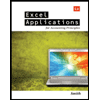
FINANCIAL & MANAGERIAL ACCT. CONNECT
9th Edition
ISBN: 9781266418211
Author: Wild
Publisher: INTER MCG
expand_more
expand_more
format_list_bulleted
Question
Chapter 11, Problem 11E
To determine
Concept Introduction:
Preferred stock dividends: Preferred stock carries preferential rights for dividends that the preferred stockholders are paid their dividends before any dividends are paid to common stockholder’s when the dividends are declared. Cumulative preferred stock gives its owners a right to be paid the current and all prior periods’ unpaid dividends.
The computation of dividends paid each year to teach two classes of stockholders.
Expert Solution & Answer
Want to see the full answer?
Check out a sample textbook solution
Students have asked these similar questions
Black Oil Company is trying to decide whether to lease or buy a new computer-assisted drilling system for its extraction business. Management has already determined that acquisition of the system has a positive NPV. The system costs $9.4 million and qualifies for a 25% CCA rate. The equipment will have a $975,000 salvage value in five years. Black Oil’s tax rate is 36%, and the firm can borrow at 9%. Cape Town Company has offered to lease the drilling equipment to Black Oil for payments of $2.15 million per year. Cape Town’s policy is to require its lessees to make payments at the start of the year.
Suppose it is estimated that the equipment will have no savage value at the end of the lease. What is the maximum lease payment acceptable to Black Oil now?
I need help with this general accounting question using the proper accounting approach.
Space Exploration Technology Corporation (Space X), is an aerospace manufacturer that sells stock engine components and tests equipment for commercial space transportation. A new customer has placed an order for eight high-bypass turbine engines, which increase fuel economy. The variable cost is $1.6 million per unit, and the credit price is $1.725 million each. Credit is extended for one period, and based on historical experience, payment for about one out of every 200 such orders is never collected. The required return is 1.8% per period.
Required
Assuming that this is a one-time order, should it be filled? The customer will not buy if credit is not extended.
What is the break-even probability of default in part 1?
Suppose that customers who don’t default become repeat customers and place the same order every period forever. Further assume that repeat customers never default. Should the order be filled? What is the break-even probability of default?
Chapter 11 Solutions
FINANCIAL & MANAGERIAL ACCT. CONNECT
Ch. 11 - Prob. 1QSCh. 11 - Prob. 2QSCh. 11 - Prob. 3QSCh. 11 - Prob. 4QSCh. 11 - Prob. 5QSCh. 11 - Prob. 6QSCh. 11 - Prob. 7QSCh. 11 - Prob. 8QSCh. 11 - Prob. 9QSCh. 11 - Prob. 10QS
Ch. 11 - Prob. 11QSCh. 11 - Prob. 12QSCh. 11 - Prob. 13QSCh. 11 - Prob. 14QSCh. 11 - Prob. 15QSCh. 11 - Prob. 16QSCh. 11 - Prob. 17QSCh. 11 - Prob. 18QSCh. 11 - Prob. 19QSCh. 11 - Prob. 20QSCh. 11 - Prob. 21QSCh. 11 - Prob. 22QSCh. 11 - QS 11-15 Basic earnings per share A1
Epic company...Ch. 11 - Prob. 24QSCh. 11 - Prob. 25QSCh. 11 - Prob. 1ECh. 11 - Prob. 2ECh. 11 - Prob. 3ECh. 11 - Prob. 4ECh. 11 - Prob. 5ECh. 11 - Prob. 6ECh. 11 - Prob. 7ECh. 11 - Prob. 8ECh. 11 - Prob. 9ECh. 11 - Prob. 10ECh. 11 - Prob. 11ECh. 11 - Prob. 12ECh. 11 - Prob. 13ECh. 11 - Prob. 14ECh. 11 - Prob. 15ECh. 11 - Prob. 16ECh. 11 - Prob. 17ECh. 11 - Prob. 18ECh. 11 - Prob. 19ECh. 11 - Prob. 20ECh. 11 - Prob. 21ECh. 11 - Prob. 22ECh. 11 - Prob. 23ECh. 11 - Prob. 24ECh. 11 - Prob. 1PSACh. 11 - Prob. 2PSACh. 11 - Prob. 3PSACh. 11 - Prob. 4PSACh. 11 - Prob. 1PSBCh. 11 - Prob. 2PSBCh. 11 - Prob. 3PSBCh. 11 - Prob. 4PSBCh. 11 - Prob. 5PSBCh. 11 - Prob. 11SPCh. 11 - Prob. 1.1AACh. 11 - Prob. 1.2AACh. 11 - Prob. 1.3AACh. 11 - Prob. 1.4AACh. 11 - Prob. 1.5AACh. 11 - Prob. 2.1AACh. 11 - Prob. 2.2AACh. 11 - Prob. 2.3AACh. 11 - Prob. 2.4AACh. 11 - Prob. 3.1AACh. 11 - Prob. 3.2AACh. 11 - Prob. 1DQCh. 11 - Prob. 2DQCh. 11 - Prob. 3DQCh. 11 - Prob. 4DQCh. 11 - Prob. 5DQCh. 11 - List the general rights of common stockholders.Ch. 11 - Prob. 7DQCh. 11 - Prob. 8DQCh. 11 - Prob. 9DQCh. 11 - Prob. 10DQCh. 11 - Prob. 11DQCh. 11 - Prob. 12DQCh. 11 - Prob. 1BTNCh. 11 - Prob. 2BTNCh. 11 - Prob. 3BTNCh. 11 - Prob. 5BTN
Knowledge Booster
Similar questions
- Can you explain the correct methodology to solve this general accounting problem?arrow_forwardPlease help me solve this general accounting question using the right accounting principles.arrow_forwardSuppose during 2025 that Federal Express reported the following information (in millions): net sales of $82,500 and net income of $185. Its balance sheet also showed total assets at the beginning of the year of $27,000 and total assets at the end of the year of $23,000. Calculate the asset turnover and return on assets. (Round answers to 2 decimal places, e.g. 6.25 or 6.25%.) Asset turnover Return on assets times %arrow_forward
- The shareholders of Barley Corporation have voted in favor of a buyout offer from Wheat Corporation. Information about each firm is given here: Barley Wheat Price/earnings ratio 13.5 21 Shares outstanding 90,000 210,000 Earnings $180,000 $810,000 Barley shareholders will receive one share of Wheat stock for every three shares they hold of Barley. Required What will the EPS of Wheat be after the merger? What will be the P/E ratio if the NPV of the acquisition is 0? What must Wheat feel is the value of the synergy between these two firms? Explain how your answer can be reconciled with the decision to go ahead with the takeover?arrow_forwardI am trying to find the accurate solution to this general accounting problem with the correct explanation.arrow_forwardPlease provide the answer to this general accounting question with proper steps.arrow_forward
- Respond to jane Plant assets of DTPW are essential to the County’s transportation services and infrastructure. These assets consist of physical, long-term resources including our vast Metrorail and Metromover systems, maintenance facilities, administrative buildings, bus depots, and train stations. DTPW depends greatly on machinery such as fare collection machines, elevators, escalators, signaling devices, and track systems which are necessary to ensure that our daily operations go off without a hitch. For example, our buses and service trucks are regarded as plant assets since they help the department fulfill its goal of providing dependable and effective transportation across the County. These assets are valuable in addition to being physically noteworthy because they reflect large investments made to preserve accessibility, safety, and public transportation. For long-term planning and financial reporting, these assets have to be properly managed and their depreciation tracked.…arrow_forwardCan you solve this general accounting question with accurate accounting calculations?arrow_forwardPlease explain the correct approach for solving this general accounting question.arrow_forward
arrow_back_ios
SEE MORE QUESTIONS
arrow_forward_ios
Recommended textbooks for you
 Corporate Financial AccountingAccountingISBN:9781305653535Author:Carl Warren, James M. Reeve, Jonathan DuchacPublisher:Cengage Learning
Corporate Financial AccountingAccountingISBN:9781305653535Author:Carl Warren, James M. Reeve, Jonathan DuchacPublisher:Cengage Learning Accounting (Text Only)AccountingISBN:9781285743615Author:Carl Warren, James M. Reeve, Jonathan DuchacPublisher:Cengage Learning
Accounting (Text Only)AccountingISBN:9781285743615Author:Carl Warren, James M. Reeve, Jonathan DuchacPublisher:Cengage Learning Intermediate Accounting: Reporting And AnalysisAccountingISBN:9781337788281Author:James M. Wahlen, Jefferson P. Jones, Donald PagachPublisher:Cengage Learning
Intermediate Accounting: Reporting And AnalysisAccountingISBN:9781337788281Author:James M. Wahlen, Jefferson P. Jones, Donald PagachPublisher:Cengage Learning Financial And Managerial AccountingAccountingISBN:9781337902663Author:WARREN, Carl S.Publisher:Cengage Learning,
Financial And Managerial AccountingAccountingISBN:9781337902663Author:WARREN, Carl S.Publisher:Cengage Learning, Financial AccountingAccountingISBN:9781337272124Author:Carl Warren, James M. Reeve, Jonathan DuchacPublisher:Cengage Learning
Financial AccountingAccountingISBN:9781337272124Author:Carl Warren, James M. Reeve, Jonathan DuchacPublisher:Cengage Learning Excel Applications for Accounting PrinciplesAccountingISBN:9781111581565Author:Gaylord N. SmithPublisher:Cengage Learning
Excel Applications for Accounting PrinciplesAccountingISBN:9781111581565Author:Gaylord N. SmithPublisher:Cengage Learning

Corporate Financial Accounting
Accounting
ISBN:9781305653535
Author:Carl Warren, James M. Reeve, Jonathan Duchac
Publisher:Cengage Learning

Accounting (Text Only)
Accounting
ISBN:9781285743615
Author:Carl Warren, James M. Reeve, Jonathan Duchac
Publisher:Cengage Learning

Intermediate Accounting: Reporting And Analysis
Accounting
ISBN:9781337788281
Author:James M. Wahlen, Jefferson P. Jones, Donald Pagach
Publisher:Cengage Learning

Financial And Managerial Accounting
Accounting
ISBN:9781337902663
Author:WARREN, Carl S.
Publisher:Cengage Learning,

Financial Accounting
Accounting
ISBN:9781337272124
Author:Carl Warren, James M. Reeve, Jonathan Duchac
Publisher:Cengage Learning

Excel Applications for Accounting Principles
Accounting
ISBN:9781111581565
Author:Gaylord N. Smith
Publisher:Cengage Learning